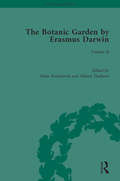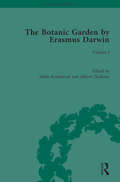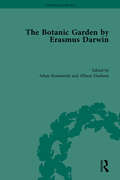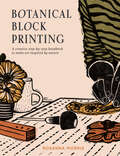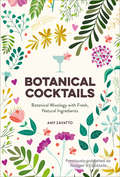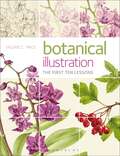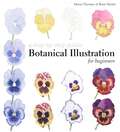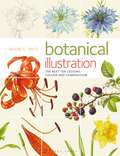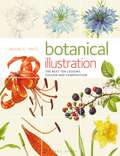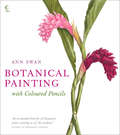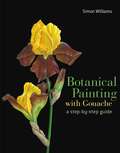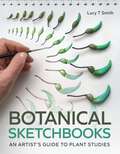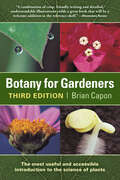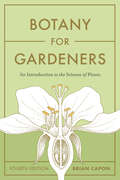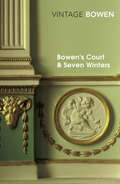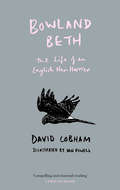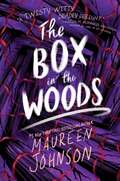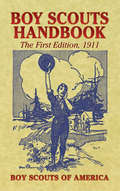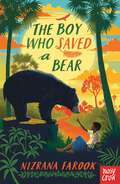- Table View
- List View
The Botanic Garden by Erasmus Darwin: Volume II (The Pickering Masters)
by Adam KomisarukThe career of Erasmus Darwin (1731-1802) affords an extraordinary glimpse into the intellectual ferment of late-eighteenth- and early-nineteenth-century Britain. As a popular poet, practicing physician, inventor of speaking machines and mechanical birds, essayer of natural history from geology to meteorology, and proponent of an evolutionary theory that inspired his famous grandson Charles, he left a lasting impression on almost every branch of knowledge. His magnum opus, and the synthesis of his myriad interests, is The Botanic Garden (1792) — an epic poem that aims to "enlist the Imagination under the banner of Science." Part I, The Economy of Vegetation, sings the praises of British industry as a dance of supernatural creatures while part II, The Loves of the Plants, wittily employs metaphors of human courtship to describe the reproductive cycles of hundreds of flowers. Darwin supplements his accomplished verses with (often much longer) "philosophical notes" that offer his idiosyncratic perspective on the scholarly controversies of the day. Despite a recent surge of academic interest in Darwin, however, no authoritative critical edition of The Botanic Garden exists, presenting a barrier to further scholarship. This two volume set comprises a complete, meticulously transcribed, reading text — including all the poetry, prose apparatus, and illustrations — along with extensive commentary that situates Darwin within contemporary debates about the natural sciences. This set will be of interest to readers as the definitive reference edition of The Botanic Garden and due to its efforts to make the work more practically and intellectually accessible to seasoned and novice readers alike This second volume includes the full version of the second part of The Botanic Garden, The Lives of Plants along with the related textual apparatus consisting of the editors’ annotations, discussion of the illustrations, textual notes, and a taxonomic table of the flowers mentioned.
The Botanic Garden by Erasmus Darwin: Volume I (The Pickering Masters)
by Adam KomisarukThe career of Erasmus Darwin (1731-1802) affords an extraordinary glimpse into the intellectual ferment of late-eighteenth- and early-nineteenth-century Britain. As a popular poet, practicing physician, inventor of speaking machines and mechanical birds, essayer of natural history from geology to meteorology, and proponent of an evolutionary theory that inspired his famous grandson Charles, he left a lasting impression on almost every branch of knowledge. His magnum opus, and the synthesis of his myriad interests, is The Botanic Garden (1792) — an epic poem that aims to "enlist the Imagination under the banner of Science." Part I, The Economy of Vegetation, sings the praises of British industry as a dance of supernatural creatures while part II, The Loves of the Plants, wittily employs metaphors of human courtship to describe the reproductive cycles of hundreds of flowers. Darwin supplements his accomplished verses with (often much longer) "philosophical notes" that offer his idiosyncratic perspective on the scholarly controversies of the day. Despite a recent surge of academic interest in Darwin, however, no authoritative critical edition of The Botanic Garden exists, presenting a barrier to further scholarship. This two volume set comprises a complete, meticulously transcribed, reading text — including all the poetry, prose apparatus, and illustrations — along with extensive commentary that situates Darwin within contemporary debates about the natural sciences. This set will be of interest to readers as the definitive reference edition of The Botanic Garden and due to its efforts to make the work more practically and intellectually accessible to seasoned and novice readers alike. The first volume presents a wide ranging and authoritative introduction to The Botanic Garden, detailing the background to the work and the various contexts in which it should be understood. These include: aesthetic theory and practice, the science of the mind, love and sexuality, politics, spirituality, the natural sciences, and evolutionary theory and the two Darwins. The full text of Part I of the The Botanic Garden, The Economy of Vegetation, then follows accompanied by the editors’ annotations, discussion of illustrations and textual notes.
The Botanic Garden by Erasmus Darwin: Volume I (The Pickering Masters)
by Adam KomisarukThe career of Erasmus Darwin (1731-1802) affords an extraordinary glimpse into the intellectual ferment of late-eighteenth- and early-nineteenth-century Britain. As a popular poet, practicing physician, inventor of speaking machines and mechanical birds, essayer of natural history from geology to meteorology, and proponent of an evolutionary theory that inspired his famous grandson Charles, he left a lasting impression on almost every branch of knowledge. His magnum opus, and the synthesis of his myriad interests, is The Botanic Garden (1792) — an epic poem that aims to "enlist the Imagination under the banner of Science." Part I, The Economy of Vegetation, sings the praises of British industry as a dance of supernatural creatures while part II, The Loves of the Plants, wittily employs metaphors of human courtship to describe the reproductive cycles of hundreds of flowers. Darwin supplements his accomplished verses with (often much longer) "philosophical notes" that offer his idiosyncratic perspective on the scholarly controversies of the day. Despite a recent surge of academic interest in Darwin, however, no authoritative critical edition of The Botanic Garden exists, presenting a barrier to further scholarship. This two volume set comprises a complete, meticulously transcribed, reading text — including all the poetry, prose apparatus, and illustrations — along with extensive commentary that situates Darwin within contemporary debates about the natural sciences. This set will be of interest to readers as the definitive reference edition of The Botanic Garden and due to its efforts to make the work more practically and intellectually accessible to seasoned and novice readers alike. The first volume presents a wide ranging and authoritative introduction to The Botanic Garden, detailing the background to the work and the various contexts in which it should be understood. These include: aesthetic theory and practice, the science of the mind, love and sexuality, politics, spirituality, the natural sciences, and evolutionary theory and the two Darwins. The full text of Part I of the The Botanic Garden, The Economy of Vegetation, then follows accompanied by the editors’ annotations, discussion of illustrations and textual notes.
The Botanic Garden by Erasmus Darwin: Volume II (The Pickering Masters)
by Adam KomisarukThe career of Erasmus Darwin (1731-1802) affords an extraordinary glimpse into the intellectual ferment of late-eighteenth- and early-nineteenth-century Britain. As a popular poet, practicing physician, inventor of speaking machines and mechanical birds, essayer of natural history from geology to meteorology, and proponent of an evolutionary theory that inspired his famous grandson Charles, he left a lasting impression on almost every branch of knowledge. His magnum opus, and the synthesis of his myriad interests, is The Botanic Garden (1792) — an epic poem that aims to "enlist the Imagination under the banner of Science." Part I, The Economy of Vegetation, sings the praises of British industry as a dance of supernatural creatures while part II, The Loves of the Plants, wittily employs metaphors of human courtship to describe the reproductive cycles of hundreds of flowers. Darwin supplements his accomplished verses with (often much longer) "philosophical notes" that offer his idiosyncratic perspective on the scholarly controversies of the day. Despite a recent surge of academic interest in Darwin, however, no authoritative critical edition of The Botanic Garden exists, presenting a barrier to further scholarship. This two volume set comprises a complete, meticulously transcribed, reading text — including all the poetry, prose apparatus, and illustrations — along with extensive commentary that situates Darwin within contemporary debates about the natural sciences. This set will be of interest to readers as the definitive reference edition of The Botanic Garden and due to its efforts to make the work more practically and intellectually accessible to seasoned and novice readers alike This second volume includes the full version of the second part of The Botanic Garden, The Lives of Plants along with the related textual apparatus consisting of the editors’ annotations, discussion of the illustrations, textual notes, and a taxonomic table of the flowers mentioned.
The Botanic Garden by Erasmus Darwin (The Pickering Masters)
by Adam Komisaruk Allison DushaneThe career of Erasmus Darwin (1731-1802) affords an extraordinary glimpse into the intellectual ferment of late-eighteenth- and early-nineteenth-century Britain. As a popular poet, practicing physician, inventor of speaking machines and mechanical birds, essayer of natural history from geology to meteorology, and proponent of an evolutionary theory that inspired his famous grandson Charles, he left a lasting impression on almost every branch of knowledge. His magnum opus, and the synthesis of his myriad interests, is The Botanic Garden (1792) — an epic poem that aims to "enlist the Imagination under the banner of Science." Part I, The Economy of Vegetation, sings the praises of British industry as a dance of supernatural creatures while part II, The Loves of the Plants, wittily employs metaphors of human courtship to describe the reproductive cycles of hundreds of flowers. Darwin supplements his accomplished verses with (often much longer) "philosophical notes" that offer his idiosyncratic perspective on the scholarly controversies of the day. Despite a recent surge of academic interest in Darwin, however, no authoritative critical edition of The Botanic Garden exists, presenting a barrier to further scholarship. This two volume set comprises a complete, meticulously transcribed, reading text — including all the poetry, prose apparatus, and illustrations — along with extensive commentary. Throughout Darwin is situated within contemporary debates about the natural sciences, the "science of the mind", aesthetics, sexuality, politics, and spirituality, among other concerns. This set will be of interest to readers across these and related disciplines as the definitive reference edition of The Botanic Garden and due to its efforts to make the work more practically and intellectually accessible to seasoned and novice readers alike.
Botanical Art from the Golden Age of Scientific Discovery
by Anna LaurentThroughout the nineteenth and twentieth centuries, wall charts were a familiar classroom component, displaying scientific images at a large scale, in full color. But it's only now that they've been superseded as a teaching tool that we have begun to realize something their ubiquity hid: they are stunning examples of botanical art at its finest. This beautifully illustrated oversized book gives the humble wall chart its due, reproducing more than two hundred of them in dazzling full color. Each wall chart is accompanied by captions that offer accessible information about the species featured, the scientists and botanical illustrators who created it, and any particularly interesting or innovative features the chart displays. And gardeners will be pleased to discover useful information about plant anatomy and morphology and species differences. We see lilies and tulips, gourds, aquatic plants, legumes, poisonous plants, and carnivorous plants, all presented in exquisite, larger-than-life detail. A unique fusion of art, science, and education, the wall charts gathered here offer a glimpse into a wonderful scientific heritage and are sure to thrill naturalists, gardeners, and artists alike.
Botanical Art from the Golden Age of Scientific Discovery
by Anna LaurentThroughout the nineteenth and twentieth centuries, wall charts were a familiar classroom component, displaying scientific images at a large scale, in full color. But it's only now that they've been superseded as a teaching tool that we have begun to realize something their ubiquity hid: they are stunning examples of botanical art at its finest. This beautifully illustrated oversized book gives the humble wall chart its due, reproducing more than two hundred of them in dazzling full color. Each wall chart is accompanied by captions that offer accessible information about the species featured, the scientists and botanical illustrators who created it, and any particularly interesting or innovative features the chart displays. And gardeners will be pleased to discover useful information about plant anatomy and morphology and species differences. We see lilies and tulips, gourds, aquatic plants, legumes, poisonous plants, and carnivorous plants, all presented in exquisite, larger-than-life detail. A unique fusion of art, science, and education, the wall charts gathered here offer a glimpse into a wonderful scientific heritage and are sure to thrill naturalists, gardeners, and artists alike.
Botanical Block Printing: A Creative Step-by-step Handbook To Make Art Inspired By Nature
by Rosanna MorrisDiscover the world of botanical block printing through an approachable guide that unveils a plethora of practical techniques and processes. This guide invites you to create stunning prints inspired by the natural world, all crafted by your own hands.
Botanical Cocktails: Botanical Mixology With Fresh, Natural Ingredients
by Amy ZavattoCraft delicious wild cocktails from foraged and grown ingredients.
Botanical Illustration: The First Ten Lessons
by Valerie PriceThis practical introduction to botanical illustration is formed of ten graded lessons, where each teaches you new skills to build upon the last. From mushrooms to orchids to hawthorn berries and leaves; once you've completed these lessons in drawing and painting botanical subjects, you will have all the techniques you need in order to tackle far more complex arrangements. An experienced teacher of botanical illustration, Valerie Price shows even the uninitiated illustrator how to produce accurate and beautiful results, with her step-by-step instructions on how to tackle each individual project.With advice on topics including accurate drawing, measuring and recording your subject, right the way through to preparing a well-composed botanical plate, this book covers everything you need to know to get ahead in botanical illustration.
Botanical Illustration: The First Ten Lessons
by Valerie PriceThis practical introduction to botanical illustration is formed of ten graded lessons, where each teaches you new skills to build upon the last. From mushrooms to orchids to hawthorn berries and leaves; once you've completed these lessons in drawing and painting botanical subjects, you will have all the techniques you need in order to tackle far more complex arrangements. An experienced teacher of botanical illustration, Valerie Price shows even the uninitiated illustrator how to produce accurate and beautiful results, with her step-by-step instructions on how to tackle each individual project.With advice on topics including accurate drawing, measuring and recording your subject, right the way through to preparing a well-composed botanical plate, this book covers everything you need to know to get ahead in botanical illustration.
Botanical Illustration The Next Ten Lessons: Colour and Composition
by Valerie PriceBuilding on Valerie Price's previous and highly successful book, Botanical Illustration: The First Ten Lessons, this next volume provides a practical introduction to colour and composition in botanical illustrations. Formed of ten graded lessons, each chapter teaches a new skill that builds upon the last, with subjects that range from red tulips and pink roses to blackberries and green foliage. Full of handy information, and with easy-to-follow exercises, the book includes step-by-step instructions that show artists of all levels how to produce beautiful colour in their compositions.This practical guide includes essential information on different watercolour techniques, how to arrange informative compositions and mix your own colours to achieve lifelike results.
Botanical Illustration The Next Ten Lessons: Colour and Composition
by Valerie PriceBuilding on Valerie Price's previous and highly successful book, Botanical Illustration: The First Ten Lessons, this next volume provides a practical introduction to colour and composition in botanical illustrations. Formed of ten graded lessons, each chapter teaches a new skill that builds upon the last, with subjects that range from red tulips and pink roses to blackberries and green foliage. Full of handy information, and with easy-to-follow exercises, the book includes step-by-step instructions that show artists of all levels how to produce beautiful colour in their compositions.This practical guide includes essential information on different watercolour techniques, how to arrange informative compositions and mix your own colours to achieve lifelike results.
Botanical Painting with Coloured Pencils
by Ann SwanThis beautifully illustrated ebook is the first practical step-by-step guide to using coloured pencils in botanical painting and is written by Ann Swan, one of the top exponents of the genre.
Botanical Sketchbooks: An Artist's Guide to Plant Studies
by Lucy SmithThis inspirational guide explains how a botanical sketchbook can take many forms and hold different meanings. It shows how a sketchbook can be used as a workbook to study plants through drawing and painting in a variety of media. It includes examples of preliminary work for finished pieces, experiments in colour and exploration of plant anatomy, and shows how these studies can be made away from the pressure of creating the perfect, polished piece of final botanical artwork. It goes on to feature sketchbooks created for their own sake as a curated space for an artist to draw and record plants over a period of time, or a particular place.
Botany for Gardeners
by Brian CaponThe essential overview of plant botany, perfect for both beginning and advanced gardeners.
Botany for Gardeners, Fourth Edition: An Introduction to the Science of Plants
by Brian Capon&“This should be the cornerstone of every gardener&’s library.&” —Jeff Gillman, Director of the UNC Charlotte Botanical Gardens What happens inside a seed after it is planted? How are plants structured? How do plants reproduce? The answers to these and other questions about complex plant processes can be found in the bestselling Botany for Gardeners. First published in 1990 with more than 260,000 copies sold, it has become the go-to introduction to botany for students and gardeners. Now in its fourth edition, Botany for Gardeners has been expanded and updated. It features a revised interior, with new photos and illustrations that clarify the concepts clearer than ever before. Additional updates address scientific advances, changes in nomenclature and taxonomy, and more. As before, Botany for Gardeners shares accessible information about how plants are organized, how they have adapted to nearly all environments on earth, their essential functions, and how they reproduce.
Bottom Gravity Currents and Overflows in Deep Channels of the Atlantic Ocean: Observations, Analysis, and Modeling
by Eugene G. Morozov Roman Y. Tarakanov Dmitry I. FreyThis book is dedicated to the analysis of bottom waters flows through underwater channels of the Atlantic Ocean. The study is based on recent observations of the authors, analysis of historical data, numerical modeling, and literature review. For example, studying both the measurements from the World Ocean Circulation experiment in the 1990s and recent measurements reveals the decadal variations of water properties in the ocean.Seawater is cooled at high latitudes, descends to the ocean bottom, and slowly flows to the tropical latitudes and further. This current is slow in the deep basins, but intensifies in the abyssal channels connecting the basins. The current overflows submarine topographic structures and sometimes forms deep cataracts when water descends over slopes by several hundred meters. The flow of Antarctic Bottom Water (AABW) is studied on the basis of CTD sections combined with Lowered Acoustic Doppler Profiling (LADCP) carried out annually, and long-term moored measurements of currents. This book is a collection of oceanographic data, interpretation, and analysis, which can be used by field oceanographers, specialists in numerical modeling, and students who specialize in oceanography.
Bowen's Court & Seven Winters
by Elizabeth BowenBowen's Court describes the history of one Anglo-Irish family in County Cork from the Cromwellian settlement until 1959, when Elizabeth Bowen was forced to sell the family house she loved. Bowen reviews ten generations of her family, representatives of the Protestant Irish gentry whose lives were dominated by property, lawsuits, formidable matriarchs, violent conflicts, hunting, drinking, and self-destructive fantasies.Seven Winters recalls with endearing candour Bowen's family and her Dublin childhood as seen through the eyes of a child who could not read till she was seven and who fed her imagination only on sights and sounds.
Bowland Beth: The Life Of An English Hen Harrier
by David Cobham‘An outstanding book’ Spectator The story of the short life and tragic death of Bowland Beth – an English Hen Harrier – which dramatically highlights the major issues in UK conservation.
The Box In The Woods (Truly Devious Ser. #4)
by Maureen JohnsonAfter solving the case of Truly Devious, Stevie Bell investigates her first mystery outside of Ellingham Academy in this spine-chilling and hilarious stand-alone mystery from New York Times bestselling author Maureen Johnson. Amateur sleuth Stevie Bell needs a good murder. After catching a killer at her high school, she's back at home for a normal (that means boring) summer. But then she gets a message from the owner of Sunny Pines, formerly known as Camp Wonder Falls-the site of the notorious unsolved case, the Box in the Woods Murders. Back in 1978, four camp counselors were killed in the woods outside of the town of Barlow Corners, their bodies left in a gruesome display. The new owner offers Stevie an invitation: Come to the camp and help him work on a true crime podcast about the case. Stevie agrees, as long as she can bring along her friends from Ellingham Academy. Nothing sounds better than a summer spent together, investigating old murders. But something evil still lurks in Barlow Corners. When Stevie opens the lid on this long-dormant case, she gets much more than she bargained for. The Box in the Woods will make room for more victims. This time, Stevie may not make it out alive. * Cosmopolitan Best YA Books of 2021 * People Magazine Best Books of Summer 2021*
Boy Scouts Handbook: The First Edition, 1911 (Dover Books On Americana Ser.)
by Boy Scouts of AmericaRead by presidents, scientists, and national heroes, the Boy Scouts Handbook has been used by generations of American youths. Filled with practical advice for everyone, the book contains everything from safety tips on swimming and instructions for putting up a tent to directions for making an aquarium and pointers on how to identify common North American trees.More than 200 figures and illustrations accompany valuable information on woodcrafting, camping, sailing, hiking, health and endurance, and providing first aid. But more than just a guide to outdoor life, the handbook also offers timeless observations on politeness, patriotism, and good citizenship.As useful and valid today as it was when first published nearly 100 years ago, the Boy Scouts Handbook will delight Americana enthusiasts as much as it will be treasured by collectors and nature lovers.
The Boy Who Saved a Bear
by Nizrana FarookA boy and a bear meet, become friends and have the adventure of their lives! From the author of The Girl Who Stole an Elephant comes another brilliant escapade. The fourth thrilling adventure set in a fictional Sri Lanka is jam-packed with peril, thieves and a terrifying bear! Nuwan works at the library, delivering books. One day, he accidentally takes away a very valuable key that's been hidden inside one of the books, and in the process thwarts the plans of some very dangerous thieves. On the run, he hides in a cave, only to discover in the middle of the night that he is sharing it with a big, hairy, terrifying bear! After some hair-raising moments, he and the bear reach an understanding and they travel on together, evading the bad guys and hoping the key will unlock the answers to the mystery so that they can stop running and return home... Cover and inside illustrations by David Dean.
